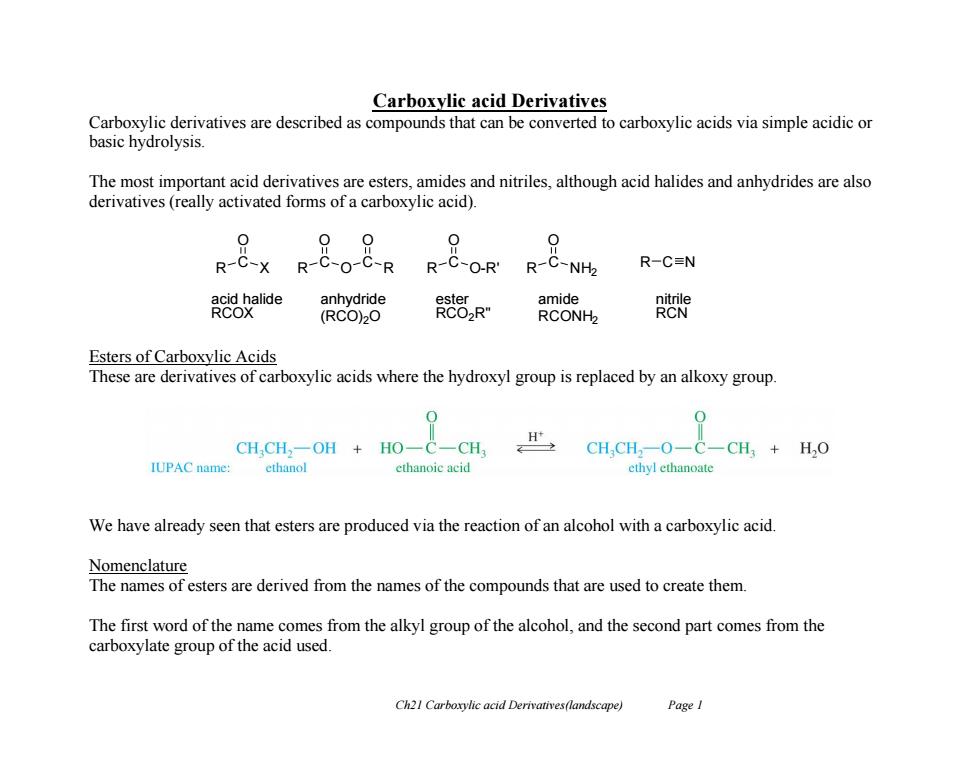
Carboxylic acid Derivatives Carboxylic derivatives are described as compounds that can be converted to carboxylic acids via simple acidic or basic hydrolysis. The most important acid derivatives are esters,amides and nitriles,although acid halides and anhydrides are also derivatives(really activated forms of a carboxylic acid). 0 R-C-X R-C-O-C-R R-C-O-R' R-C-NH2 R-C=N Rooxalide anhydride (RCO)O 882R amide RCONH2 R心9 Esters of Carboxylic Acids These are derivatives of carboxylic acids where the hydroxyl group is replaced by an alkoxy group. H CHCH一OH+HO C-CH CHCH,-0-C-CH+HO IUPAC name: ethanol ethanoic acid cthyl ethanoate We have already seen that esters are produced via the reaction of an alcohol with a carboxylic acid. Nomenclature The names of esters are derived from the names of the compounds that are used to create them. The first word of the name comes from the alkyl group of the alcohol,and the second part comes from the carboxylate group of the acid used. Ch21 Carboxylic acid Derivatives(landscape) Page I
Ch21 Carboxylic acid Derivatives(landscape) Page 1 Carboxylic acid Derivatives Carboxylic derivatives are described as compounds that can be converted to carboxylic acids via simple acidic or basic hydrolysis. The most important acid derivatives are esters, amides and nitriles, although acid halides and anhydrides are also derivatives (really activated forms of a carboxylic acid). Esters of Carboxylic Acids These are derivatives of carboxylic acids where the hydroxyl group is replaced by an alkoxy group. We have already seen that esters are produced via the reaction of an alcohol with a carboxylic acid. Nomenclature The names of esters are derived from the names of the compounds that are used to create them. The first word of the name comes from the alkyl group of the alcohol, and the second part comes from the carboxylate group of the acid used. R C X O R C O O R C O-R' O R C NH2 O C O R R C N acid halide RCOX anhydride (RCO)2O ester RCO2R" amide RCONH2 nitrile RCN
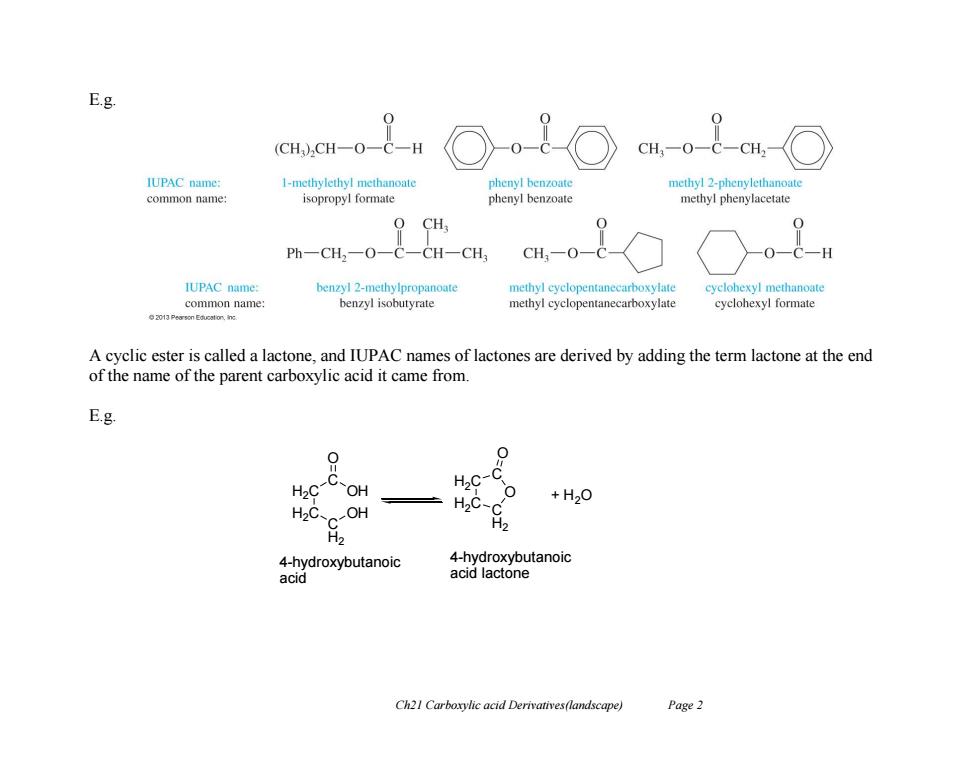
E.g. (CH)2CH-O一C-H CH,-OC-CH2 IUPAC name: 1-methylethyl methanoate phenyl benzoate methyl 2-phenylethanoate common name isopropyl formate phenyl benzoate methyl phenylacetate 0 CH Ph一CH2一O一C一CH一CH CH一O -0-C-H IUPAC name: benzyl 2-methylpropanoate methyl cyclopentanecarboxylate cyclohexyl methanoate common name: benzyl isobutyrate methyl cyclopentanecarboxylate cyclohexyl formate A cyclic ester is called a lactone,and IUPAC names of lactones are derived by adding the term lactone at the end of the name of the parent carboxylic acid it came from. E.g. Hc-C OH HC-C H2C-C +H2O H2C. C-OH 4-hydroxybutanoic 4-hydroxybutanoic acid acid lactone Ch21 Carboxylie acid Derivatives(landscape) Page 2
Ch21 Carboxylic acid Derivatives(landscape) Page 2 E.g. A cyclic ester is called a lactone, and IUPAC names of lactones are derived by adding the term lactone at the end of the name of the parent carboxylic acid it came from. E.g. H2C H2C C H2 OH OH C O H2C H2C C H2 O C O + H2O 4-hydroxybutanoic acid 4-hydroxybutanoic acid lactone
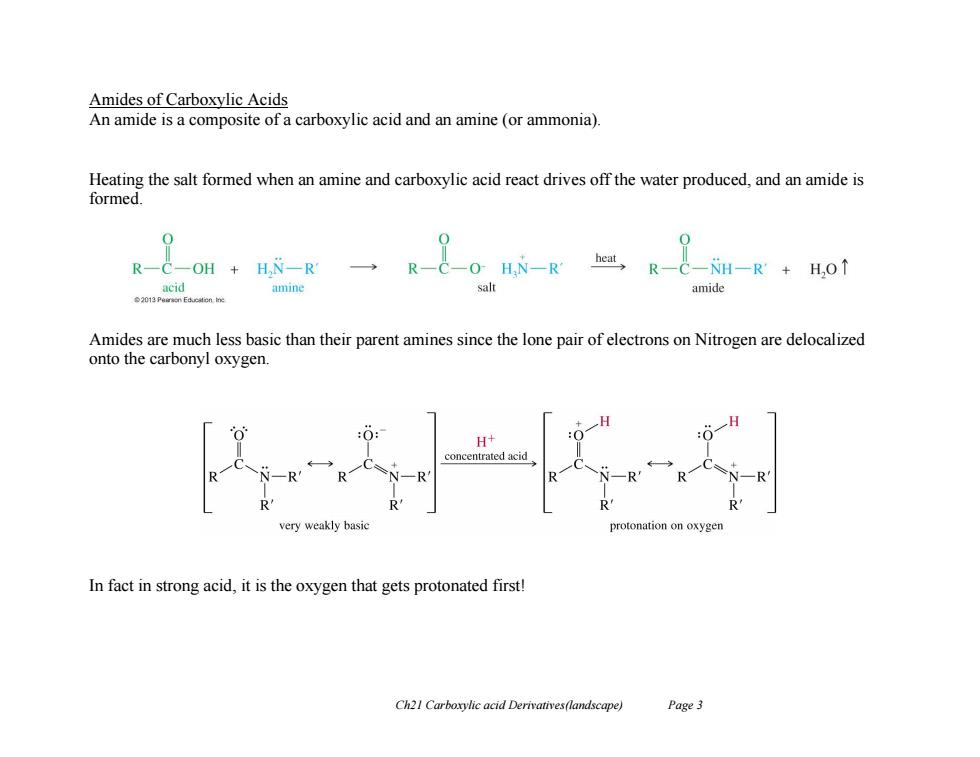
Amides of Carboxylic Acids An amide is a composite of a carboxylic acid and an amine (or ammonia). Heating the salt formed when an amine and carboxylic acid react drives off the water produced,and an amide is formed. 0 R-C-OH H,N-R C一OHN-R hetR-C-NH一R+H,OT amine salt amide Amides are much less basic than their parent amines since the lone pair of electrons on Nitrogen are delocalized onto the carbonyl oxygen. H+ concentrated acid very weakly basic protonation on oxyger In fact in strong acid,it is the oxygen that gets protonated first! Ch21 Carboxylic acid Derivatives(landscape) Page 3
Ch21 Carboxylic acid Derivatives(landscape) Page 3 Amides of Carboxylic Acids An amide is a composite of a carboxylic acid and an amine (or ammonia). Heating the salt formed when an amine and carboxylic acid react drives off the water produced, and an amide is formed. Amides are much less basic than their parent amines since the lone pair of electrons on Nitrogen are delocalized onto the carbonyl oxygen. In fact in strong acid, it is the oxygen that gets protonated first!
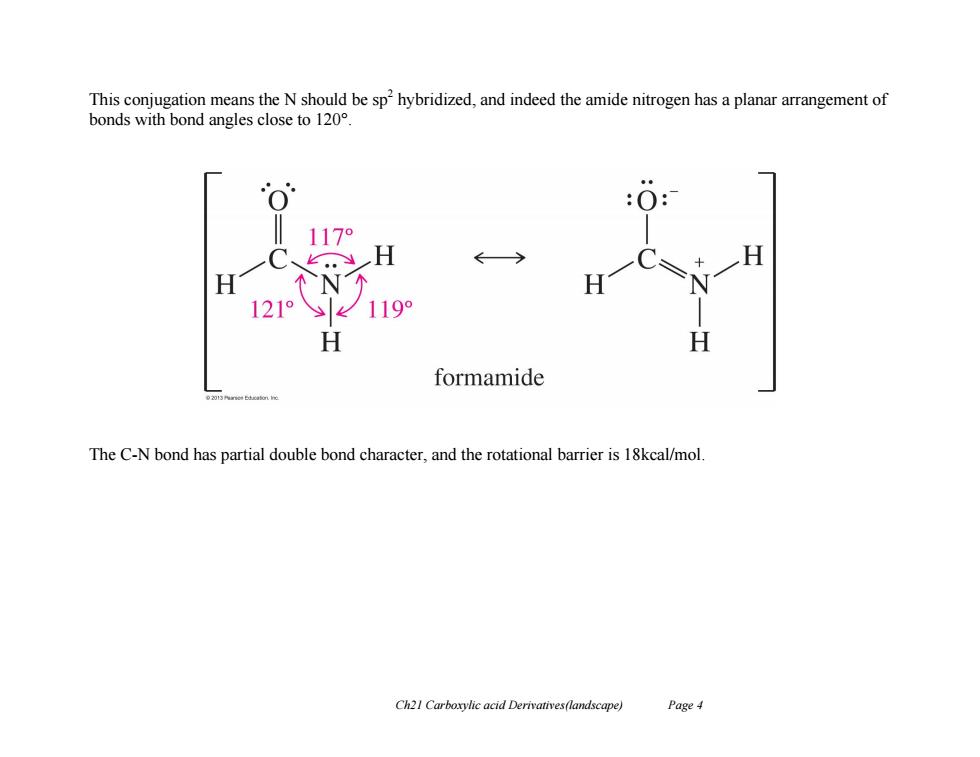
This conjugation means the N should be sp'hybridized,and indeed the amide nitrogen has a planar arrangement of bonds with bond angles close to 120. 117 .,H H 121° 119° H formamide The C-N bond has partial double bond character,and the rotational barrier is 18kcal/mol. Ch21 Carboxylie acid Derivatives(landscape) Page 4
Ch21 Carboxylic acid Derivatives(landscape) Page 4 This conjugation means the N should be sp2 hybridized, and indeed the amide nitrogen has a planar arrangement of bonds with bond angles close to 120°. The C-N bond has partial double bond character, and the rotational barrier is 18kcal/mol
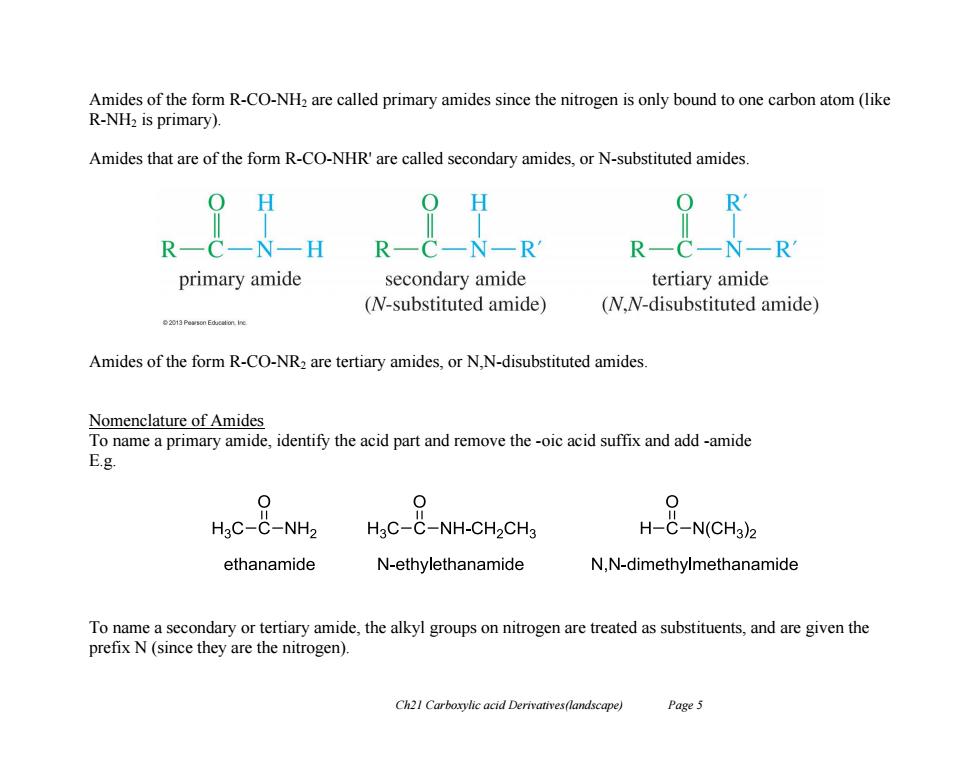
Amides of the form R-CO-NH2 are called primary amides since the nitrogen is only bound to one carbon atom(like R-NH2 is primary). Amides that are of the form R-CO-NHR'are called secondary amides.or N-substituted amides. H R-C-N-R RC-NR primary amide secondary amide tertiary amide (N-substituted amide) (N.N-disubstituted amide) 13Pen En re Amides of the form R-CO-NR2 are tertiary amides,or N,N-disubstituted amides Nomenclature of Amides To name a primary amide,identify the acid part and remove the-oic acid suffix and add-amide E.g. 0 H3C-C-NH2 HgC-C-NH-CH2CH3 H-C-N(CH3)2 ethanamide N-ethylethanamide N.,N-dimethylmethanamide To name a secondary or tertiary amide,the alkyl groups on nitrogen are treated as substituents,and are given the prefix N(since they are the nitrogen). Ch21 Carboxylic acid Derivatives(landscape) Page 5
Ch21 Carboxylic acid Derivatives(landscape) Page 5 Amides of the form R-CO-NH2 are called primary amides since the nitrogen is only bound to one carbon atom (like R-NH2 is primary). Amides that are of the form R-CO-NHR' are called secondary amides, or N-substituted amides. Amides of the form R-CO-NR2 are tertiary amides, or N,N-disubstituted amides. Nomenclature of Amides To name a primary amide, identify the acid part and remove the -oic acid suffix and add -amide E.g. To name a secondary or tertiary amide, the alkyl groups on nitrogen are treated as substituents, and are given the prefix N (since they are the nitrogen)